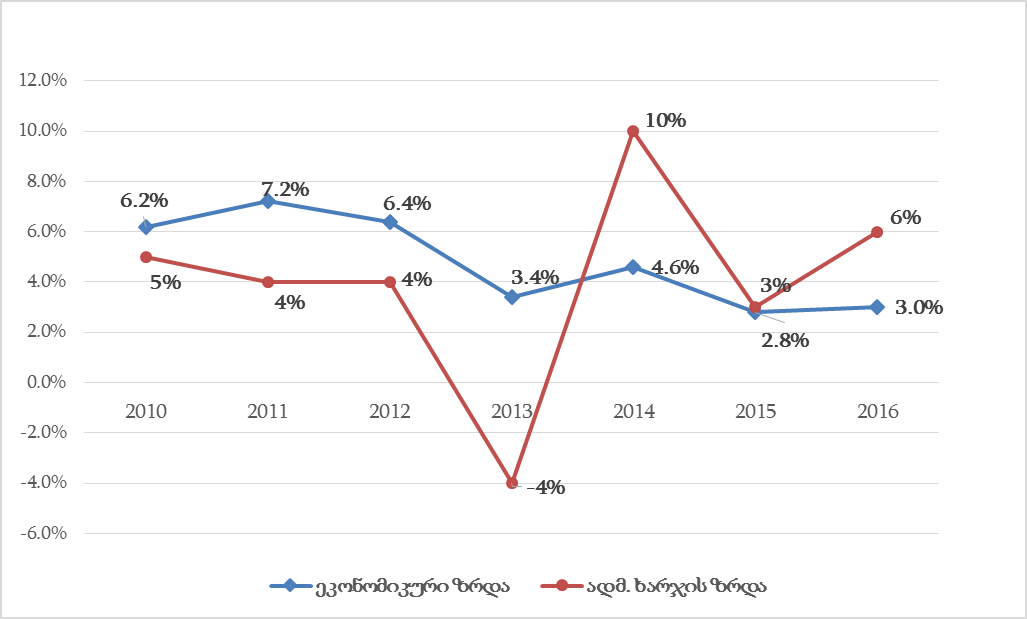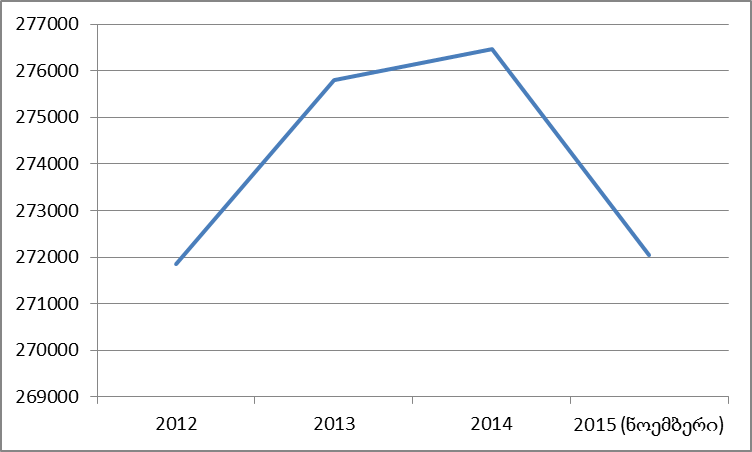On 11 December 2015, at the plenary session of the Parliament of Georgia, the leader of the New Political Centre – Girchi, Zurab Japaridze, stated: "The number of the population below the poverty line was 9.2% in 2011. Now, it is 11.6% which means that the situation has worsened."
FactCheck took interest in Zurab Japaridze’s statement and verified its accuracy.
According to the data of the National Statistics Office of Georgia, the registered poverty in 2011, or the number of the population below the poverty line, was 9.2%, increasing to 9.7% in 2012 and 2013. This indicator increased significantly in 2014, amounting to 11.6%. However, this increase was mainly due to the results of the universal population census. According to the National Statistics Office of Georgia, the 2014 data were calculated based upon the preliminary results of the 5 November 2014 population census. Preliminary results from the census illustrate that the number of the population below the poverty line dropped from 4,732,000 (2002 census data) to 3,730,000. Hence, the ratio of citizens below the poverty line to the overall number of the population increased. As for the data of registered poverty for the previous years, they have not yet been recalculated based upon the 2014 census results.
In an interview with us, a representative of the National Statistics Office of Georgia confirmed that the registered poverty indicator did not increase in 2014 but, in fact, dropped in nominal numbers. The changes in percentage, on the other hand, were due to the drastic decrease in the number of the population evidenced in the 2014 universal population census. According to the representative’s statement, poverty data for the previous years will also increase significantly if they are calculated based upon the decreased number of 3.7 million people.
Chart 1: Registered Poverty in %
 It should be pointed out that the National Statistics Office calculates the poverty level by the number of people receiving subsistence allowances. According to the data of the Social Service Agency, the number of population receiving the subsistence allowance (or the number of people below the poverty line) decreased significantly. A total of 501,445 people were receiving the subsistence allowance at the end of 2012 whilst by November 2015 this number had fallen to 371,323 which was partly due to the changes in the methodology for assessing households of socially vulnerable families. The Opposition continues to actively protesting these changes.
It is true that individuals receiving the subsistence allowance should be registered as being below the poverty line; however, determining the level of poverty based upon this indicator alone does not give an adequate picture. The National Statistics Office of Georgia also uses median consumption for determining the level of poverty in the country. This is called relative poverty. According to this indicator, the share of the population in 2014 which consumed less than 60% of average consumption was 21.4%. About 8% of the population consumed less than 40% of average consumption. These indicators were higher in 2011 and 2012 (see Chart 2).
Chart 2: Relative Poverty in %
It should be pointed out that the National Statistics Office calculates the poverty level by the number of people receiving subsistence allowances. According to the data of the Social Service Agency, the number of population receiving the subsistence allowance (or the number of people below the poverty line) decreased significantly. A total of 501,445 people were receiving the subsistence allowance at the end of 2012 whilst by November 2015 this number had fallen to 371,323 which was partly due to the changes in the methodology for assessing households of socially vulnerable families. The Opposition continues to actively protesting these changes.
It is true that individuals receiving the subsistence allowance should be registered as being below the poverty line; however, determining the level of poverty based upon this indicator alone does not give an adequate picture. The National Statistics Office of Georgia also uses median consumption for determining the level of poverty in the country. This is called relative poverty. According to this indicator, the share of the population in 2014 which consumed less than 60% of average consumption was 21.4%. About 8% of the population consumed less than 40% of average consumption. These indicators were higher in 2011 and 2012 (see Chart 2).
Chart 2: Relative Poverty in %
 In order to analyse the poverty trends, we also looked into UNICEF’s survey of well-being which is conducted every two years (2015 data are not yet available). According to the data for 2013 (see survey, p. 37, Chart 4.6), the level of poverty of the population improved after 2011. The share of individuals whose daily expenses were less than USD 1.25 (people in extreme poverty) dropped from 9.1% to 3.9%. The share of people whose expenses were less than USD 2.50 decreased from 37.9% to 24.6% (people in general poverty).
Conclusion
According to the data of the National Statistics Office of Georgia, the share of people below the poverty line was 9.2% in 2011. It is true that this indicator increased to 11.6% in 2014; however, this was mainly due to the results of the 2014 universal population census and it does not mean that the share of people below the poverty line has actually increased. As a result of the population census, the overall number of the population decreased significantly which caused the share of those below the poverty line to increase. According to the data of the Social Service Agency, the number of people below the poverty line fell significantly in 2015. In addition, this was also partly due to the changes in the methodology for assessing households of socially vulnerable families.
According to the data of the National Statistics Office of Georgia, the share of the population consuming less than 40% or 60% of the average consumption dropped as compared to 2011 and 2012. In addition, according to UNICEF’s well-being survey, the poverty level of the population (both extreme as well as general) has improved since 2011.
Despite the fact that the level of poverty has decreased over the past few years, the existing numbers are still very high and poverty remains among the significant challenges for a large part of the population.
FactCheck concludes that Zurab Japaridze’s statement: "The number of the population below the poverty line was 9.2% in 2011. Now, it is 11.6% which means that the situation has worsened," is FALSE.
In order to analyse the poverty trends, we also looked into UNICEF’s survey of well-being which is conducted every two years (2015 data are not yet available). According to the data for 2013 (see survey, p. 37, Chart 4.6), the level of poverty of the population improved after 2011. The share of individuals whose daily expenses were less than USD 1.25 (people in extreme poverty) dropped from 9.1% to 3.9%. The share of people whose expenses were less than USD 2.50 decreased from 37.9% to 24.6% (people in general poverty).
Conclusion
According to the data of the National Statistics Office of Georgia, the share of people below the poverty line was 9.2% in 2011. It is true that this indicator increased to 11.6% in 2014; however, this was mainly due to the results of the 2014 universal population census and it does not mean that the share of people below the poverty line has actually increased. As a result of the population census, the overall number of the population decreased significantly which caused the share of those below the poverty line to increase. According to the data of the Social Service Agency, the number of people below the poverty line fell significantly in 2015. In addition, this was also partly due to the changes in the methodology for assessing households of socially vulnerable families.
According to the data of the National Statistics Office of Georgia, the share of the population consuming less than 40% or 60% of the average consumption dropped as compared to 2011 and 2012. In addition, according to UNICEF’s well-being survey, the poverty level of the population (both extreme as well as general) has improved since 2011.
Despite the fact that the level of poverty has decreased over the past few years, the existing numbers are still very high and poverty remains among the significant challenges for a large part of the population.
FactCheck concludes that Zurab Japaridze’s statement: "The number of the population below the poverty line was 9.2% in 2011. Now, it is 11.6% which means that the situation has worsened," is FALSE.
 It should be pointed out that the National Statistics Office calculates the poverty level by the number of people receiving subsistence allowances. According to the data of the Social Service Agency, the number of population receiving the subsistence allowance (or the number of people below the poverty line) decreased significantly. A total of 501,445 people were receiving the subsistence allowance at the end of 2012 whilst by November 2015 this number had fallen to 371,323 which was partly due to the changes in the methodology for assessing households of socially vulnerable families. The Opposition continues to actively protesting these changes.
It is true that individuals receiving the subsistence allowance should be registered as being below the poverty line; however, determining the level of poverty based upon this indicator alone does not give an adequate picture. The National Statistics Office of Georgia also uses median consumption for determining the level of poverty in the country. This is called relative poverty. According to this indicator, the share of the population in 2014 which consumed less than 60% of average consumption was 21.4%. About 8% of the population consumed less than 40% of average consumption. These indicators were higher in 2011 and 2012 (see Chart 2).
Chart 2: Relative Poverty in %
It should be pointed out that the National Statistics Office calculates the poverty level by the number of people receiving subsistence allowances. According to the data of the Social Service Agency, the number of population receiving the subsistence allowance (or the number of people below the poverty line) decreased significantly. A total of 501,445 people were receiving the subsistence allowance at the end of 2012 whilst by November 2015 this number had fallen to 371,323 which was partly due to the changes in the methodology for assessing households of socially vulnerable families. The Opposition continues to actively protesting these changes.
It is true that individuals receiving the subsistence allowance should be registered as being below the poverty line; however, determining the level of poverty based upon this indicator alone does not give an adequate picture. The National Statistics Office of Georgia also uses median consumption for determining the level of poverty in the country. This is called relative poverty. According to this indicator, the share of the population in 2014 which consumed less than 60% of average consumption was 21.4%. About 8% of the population consumed less than 40% of average consumption. These indicators were higher in 2011 and 2012 (see Chart 2).
Chart 2: Relative Poverty in %
 In order to analyse the poverty trends, we also looked into UNICEF’s survey of well-being which is conducted every two years (2015 data are not yet available). According to the data for 2013 (see survey, p. 37, Chart 4.6), the level of poverty of the population improved after 2011. The share of individuals whose daily expenses were less than USD 1.25 (people in extreme poverty) dropped from 9.1% to 3.9%. The share of people whose expenses were less than USD 2.50 decreased from 37.9% to 24.6% (people in general poverty).
Conclusion
According to the data of the National Statistics Office of Georgia, the share of people below the poverty line was 9.2% in 2011. It is true that this indicator increased to 11.6% in 2014; however, this was mainly due to the results of the 2014 universal population census and it does not mean that the share of people below the poverty line has actually increased. As a result of the population census, the overall number of the population decreased significantly which caused the share of those below the poverty line to increase. According to the data of the Social Service Agency, the number of people below the poverty line fell significantly in 2015. In addition, this was also partly due to the changes in the methodology for assessing households of socially vulnerable families.
According to the data of the National Statistics Office of Georgia, the share of the population consuming less than 40% or 60% of the average consumption dropped as compared to 2011 and 2012. In addition, according to UNICEF’s well-being survey, the poverty level of the population (both extreme as well as general) has improved since 2011.
Despite the fact that the level of poverty has decreased over the past few years, the existing numbers are still very high and poverty remains among the significant challenges for a large part of the population.
FactCheck concludes that Zurab Japaridze’s statement: "The number of the population below the poverty line was 9.2% in 2011. Now, it is 11.6% which means that the situation has worsened," is FALSE.
In order to analyse the poverty trends, we also looked into UNICEF’s survey of well-being which is conducted every two years (2015 data are not yet available). According to the data for 2013 (see survey, p. 37, Chart 4.6), the level of poverty of the population improved after 2011. The share of individuals whose daily expenses were less than USD 1.25 (people in extreme poverty) dropped from 9.1% to 3.9%. The share of people whose expenses were less than USD 2.50 decreased from 37.9% to 24.6% (people in general poverty).
Conclusion
According to the data of the National Statistics Office of Georgia, the share of people below the poverty line was 9.2% in 2011. It is true that this indicator increased to 11.6% in 2014; however, this was mainly due to the results of the 2014 universal population census and it does not mean that the share of people below the poverty line has actually increased. As a result of the population census, the overall number of the population decreased significantly which caused the share of those below the poverty line to increase. According to the data of the Social Service Agency, the number of people below the poverty line fell significantly in 2015. In addition, this was also partly due to the changes in the methodology for assessing households of socially vulnerable families.
According to the data of the National Statistics Office of Georgia, the share of the population consuming less than 40% or 60% of the average consumption dropped as compared to 2011 and 2012. In addition, according to UNICEF’s well-being survey, the poverty level of the population (both extreme as well as general) has improved since 2011.
Despite the fact that the level of poverty has decreased over the past few years, the existing numbers are still very high and poverty remains among the significant challenges for a large part of the population.
FactCheck concludes that Zurab Japaridze’s statement: "The number of the population below the poverty line was 9.2% in 2011. Now, it is 11.6% which means that the situation has worsened," is FALSE.
Tags:








